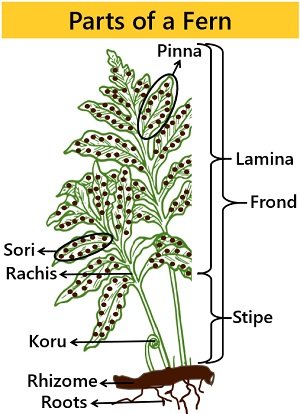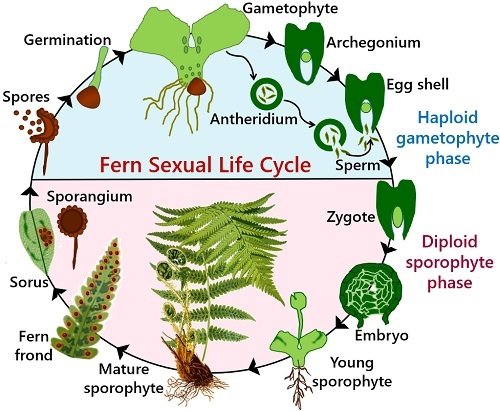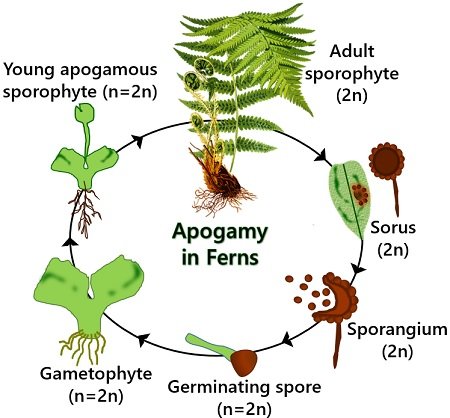Do you know how ferns reproduce? Well, ferns are seedless, flowerless vascular plants. But, they can undergo both asexual and sexual modes of reproduction. The majority of ferns undergo sexual reproduction through spores.
If you look underside the ferns leaf, you will find a row of small spots, called sori. Such spots are visible in spring and summer. Each spot encases tiny spores that shed off in the late summer.
It is the time when spores find a suitable damp spot to germinate. First, a small gametophyte develops from the spore containing half the genetic code. Further growth leads to the development of the sporophyte plant.
The fern sporophyte contains spores having a complete genetic code. Thus, ferns reproduce sexually via spores even though flowers are absent. Some ferns may reproduce via asexual means as well.
Apogamy, the proliferation of baby ferns and rhizome proliferation are the asexual methods. In this post, we will discuss the meaning and characteristics of ferns. Also, we will study different modes of fern reproduction in detail.
Content: How do Ferns Reproduce?
What are Ferns?
Ferns are seedless and non-flowering vascular plants. They constitute the most diversified group of primitive vascular plants. Most of them live in humid tropics and temperate regions. Some also live under sub-arctic conditions.
Structure
Ferns comprise of three major parts:
- Rhizome (Modified stem)
- Fronds (Leaves)
- Sporangia (Reproductive structures)
These three components are the basis of ferns classification and identification.

Rhizomes
Ferns have a rhizome (a modified stem) that exists in three basic forms:
- A rhizome may grow upwards and appear as a solid mass. It develops a tuft of fronds. Example: King or Crown fern.
- Rhizomes grow in a lateral fashion and propagate along or under the ground. They may ascend up a tree. Hound’s tongue and Thread ferns are examples.
- A vertical rhizome seems like a short or tall trunk. Example: Silver fern.
Fronds
The fronds are the fern leaves, which can be simple and undivided. A stalk or stipe holds the leaflets with a flat blade (the lamina). Lamina possesses variable pinnae.

Fiddlehead or Koru are the tightly-coiled new fronds. On maturation, these slowly uncoil. Fronds perform two significant functions:
- Photosynthesis
- Reproduction
Sporangia
They encase the spores and appear underside of fronds. Not all the fronds carry sporangia (hold spores) underneath their surface. Only fertile fronds have sporangia.
In the majority of ferns, sporangia cluster into sori. These exist as brown, black or orange spots. In some ferns, the indusium is a membrane protecting sporangia.
Sporangia are sometimes exposed to air. When the sporangia break open, they release spores into the environment.
Characteristics of Ferns
- For growth, ferns need moist, warm places. But, some may grow in dry and cold areas.
- The mature plant body contains true stems, leaves and roots.
- Ferns have a rhizome (a modified stem) that grows underground. While a few have the above-ground stem.
- The roots of ferns are adventitious.
- Fronds are the fern leaves. The leaves can be simple or pinnately compound.
- Young leaves have circinate ptyxis, i.e. appear coiled.
- Ramenta are hairy structures. These are present around younger parts of the stem, leaves and rachis. These structures protect the plant from mechanical damage and water loss.
- Sporangia cluster into sori underside the fertile leaves or sporophylls.
- Prothallus is the Fern gametophyte. It is free-living, comprising both male and female sex organs.
- Male sex organs or antheridia appear as small hemispherical structures. They have a three-celled jacket encircling 32-48 sperm cells. Sperms are multi-ciliate or multi-flagellate.
- Female sex organs or archegonia appear flask-shaped. A young sporophyte originates from the archegonium.
Fern Sexual Reproduction
The sexual life cycle of the fern occurs via spores. It has an alternation of generations. Also, an embryo stage is present.
- One is diploid sporophyte generation. A fern sporophyte is a spore-producing plant. It carries two identical sets of chromosomes in each cell.
- And the other is haploid gametophyte generation. A fern gametophyte is a gamete-producing plant. It has one set of chromosomes within each cell.

When the fern sporophyte matures, spores release out of the sporangia. Spores are rusty-looking present underside the tips of the fern leaves. These spores disperse through wind, water or air current. Later, spores fall onto different substratum.
In favourable conditions, the spore germinates and develop the fern gametophyte. During this stage, male and female sex organs develop, and fertilization occurs.
After fertilization, the zygote develops into an embryo. After successive division, the embryo turns into a sporophyte plant. On maturation, true leaves of sporophyte produce sporangia. These encase spores on the frond’s dorsal surface.
Sporangium matures, and the spores release into the environment under unfavourable conditions. Thus, the germination of each spore gives rise to the sporophyte. Let us summarise the steps involved in the fern’s sexual life cycle.
Haploid Gametophyte Phase
Step-1: The fern sporophyte discharges spores in the summer. Then, the released spore must land on the suitable substratum to grow and germinate. Spores germinate best in moist places.
Step-2: Spores germinate into the flat, thin and heart-shaped gametophyte plant in favourable conditions. They are green and photosynthetic. They resemble the gametophytes of several liverworts.
Step-3: Rhizoids project out from the lower surface of the gametophyte. The fern gametophyte holds both male and female sex organs.
- Archegonia are the female egg-producing organs. These exist on the gametophyte’s lower surface near the apical notch. And each archegonium comprises one gamete or sex cell on the venter.
- Its upper part or neck contains four rows of central neck cells. The uppermost cells are the neck canal cells.
- The lowermost cell contains a ventral canal cell. It is present above the egg.
- Antheridia are the male sperm-producing organs. These are also found on the lower surface of the fern gametophyte. Each antheridium holds a layer of sterile cells around a sperm-producing cell layer. Antheridia appear recessed or protruding.
Step-4: As the sperm matures within the antheridia, they release out. For this, sperms need water passage or film to swim towards the mouth of antheridia.
Step-5: The released sperms attract by the chemicals released from the archegonium. Now, the neck of the archegonium spreads at the apex, allowing sperms to enter. Thereby, sperms make their way inside or penetrate the archegonium.
Step-6: The body of sperm consists of nuclear material. A band of cilia is also present around the sperm body for locomotion. The sperm fuses with a single egg, resulting in zygote formation. After fertilization, the neck of the archegonium closes.
Diploid Sporophyte Phase
Step-1: Then, the zygote divides and differentiates into the embryo within the archegonial venter. The embryo remains confined in the gametophyte.
Step-2: Later, the embryo breaks and develops into an independent plant or sporophyte. The young sporophyte plant remains attached to the gametophyte. Soon, the sporophyte matures and gets bigger than the gametophyte. Also, it gets nutritionally independent from it.
Step-3: In later stages, subterranean stems or rhizomes originate. These appear thread-like and creep upon or beneath the ground. When the fern sporophyte matures, true roots arise from rhizomes.
They appear thin or wiry and absorb soil water and nutrients. Rhizomes bear leaves or fronds. They appear feather-like with smaller side branches. The immature leaves have coiled or circinate vernation.
Step-4: The mature leaves bear sporangia on the lower surface. There, these sporangia differentiate into clusters called sori. Then meiosis occurs within the sporangia. Eventually, these sporangia release haploid spores.
Later, each spore gives rise to the photosynthetic prothallus (gametophyte) via mitosis. It maintains the number of haploid chromosomes within the prothallus. In this way, the ferns undergo two generations to complete their life cycle.
Fern Asexual Reproduction
Some ferns also reproduce through asexual methods like:
Apogamy
It involves the development of gametophyte from the sporophyte without fertilization. Ferns undergo apogamy due to the following reasons:
- When surrounding conditions are too dry.
- Secondly, when there is a lack of minerals in the soil.

Thus, apogamy occurs when the surrounding conditions do not favour fertilization.
Proliferous Frond Tips
Some ferns develop baby ferns at proliferous frond tips. It is a quick method of asexual reproduction. Here, the growth of baby fern results in drooping of frond towards the ground.
Then, the baby fern roots itself. As a result, it grows independent from the parent plant. But, the number of genes in the proliferous baby plant is equal to its parent.
Rhizome Spreading
It is another method of quick asexual reproduction in ferns. Some ferns undergo reproduction through rhizomes proliferation.
The rhizomes are the fibrous structures that resemble roots. But, they are modified stems that can spread through soil, sprouting new ferns. Also, the new ferns are identical to their parents in this method.
Conclusion
Thus, ferns reproduce via sexual or asexual methods. And they have different adaptations to undergo reproduction. In sexual reproduction, a haploid spore develops into a haploid gametophyte. Under enough moisture supply, the fertilization of gametophytes occurs.
After that, the haploid gametophyte matures into a diploid sporophyte. Later, the sporophyte produces spores, completing the life cycle. Asexual methods of fern reproduction include apogamy, proliferous frond tips, and rhizome proliferation.